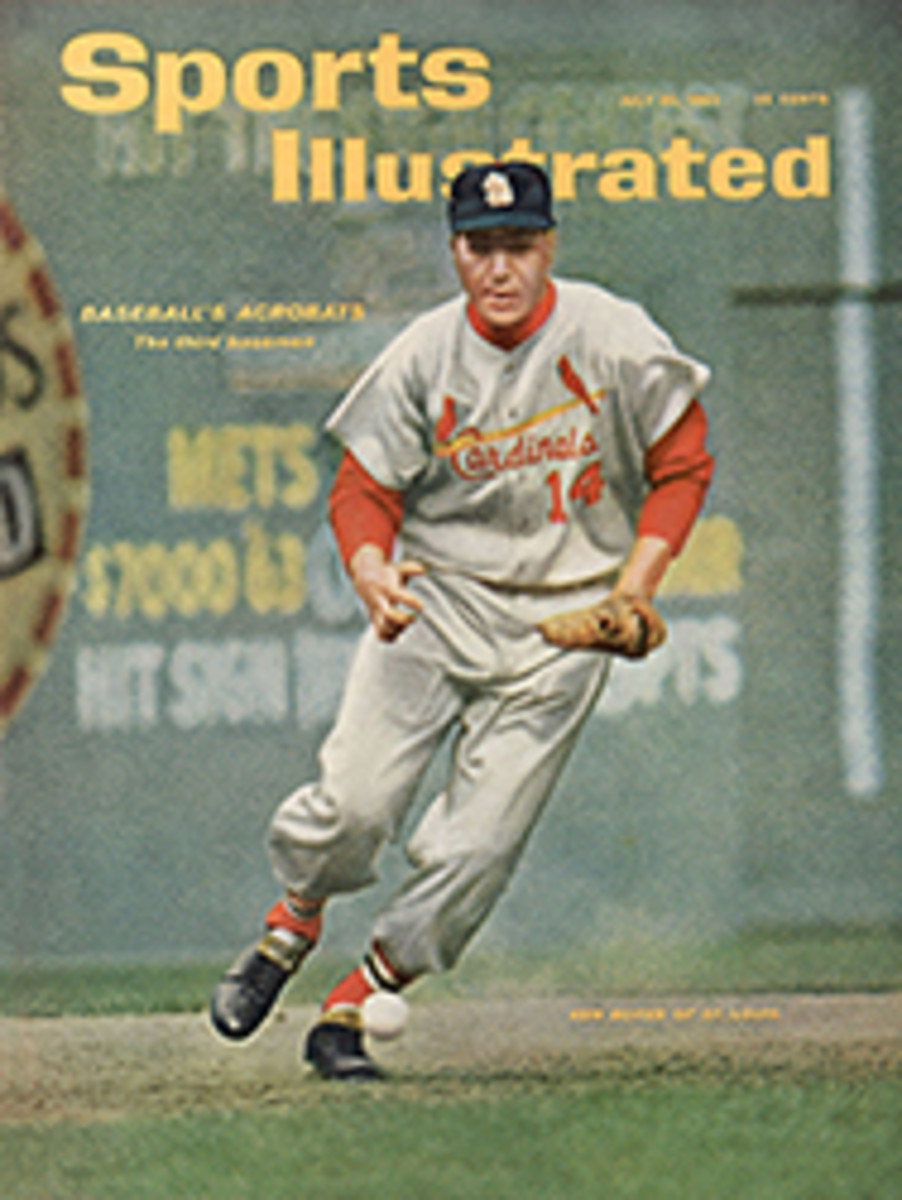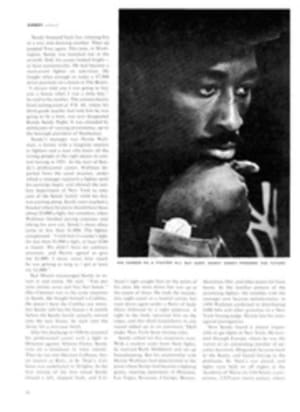
SCORECARD
MENDER OF IMMORTALS
After Dr. George E. Bennett died at 77 last week a photograph was found in a desk drawer of his Baltimore office. It showed Joe DiMaggio, Tommy Hen-rich, Charley Keller and Frankie Crosetti in their Yankee uniforms and was inscribed: "To Dr. George, the man who made this picture possible." Most men would have hung it prominently on a wall, but Dr. George was modest.
The inscription was true. DiMaggio was remembering an injury to his elbow. Dr. Bennett removed loose cartilage, caused by Joe's long throws, from the tendons. Henrich and Crosetti had remodeled knees, Keller a repaired ankle. Without the skills of the famed Johns Hopkins orthopedic surgeon, the careers of all four, and of many others, would have been ended prematurely.
Big league clubs sent their players to Dr. Bennett because he was more than a gifted surgeon. His medical skill was supported by an extraordinary knowledge of baseball (he had played on a semipro team). He knew, for example, that a shortstop's most difficult play is going into the hole to scoop up a drive. When he gets the ball he must pivot on his right leg to make the long throw to first base. So when a shortstop came to him with a bad right knee, Dr. Bennett simply recommended that the shortstop become a third baseman.
Another time it was a pitcher who wrote that he had lost his fast ball. Dr. Bennett had operated on the boy's arm a few months before. "I figured he was favoring it by pushing the ball and not throwing it," Dr. Bennett recalled. He wrote a brief prescription: "Cock your wrist." Two days later a telegram arrived. "It worked," the wire said.
Larry MacPhail believes Dr Bennett was responsible for the Dodgers' 1941 pennant. Whitlow Wyatt's control went sour, and MacPhail appealed to the doctor. "Build a mound in the bullpen," Dr. Bennett said. MacPhail scoffed but did it anyhow. That year Wyatt won 22 games. The doctor believed Wyatt's throwing motion was perfect and "had a movie made of it to show other pitchers.
Not only baseball players but other athletes flocked to Dr. Bennett's office. Eddie Arcaro says the doctor saved his career. Among football players he treated were John Unitas, Ray Berry, George Shaw and Don McIlhenny.
At a testimonial dinner in 1958, athletes he had helped paid tribute to him, some tearfully. Joe Garagiola relieved the tension with a remark: "After listening to that all-star team of players Dr. Bennett has mended," he said, "I'm sorta sorry I didn't break my leg."
THE BROKEN-BAT BRIGADE
The trend to ultralight fishing tackle is as nothing compared to the burgeoning use of ultralight bats in baseball. More and more players are going to the featherweight stick under the assumption that a quick, lashing swing will propel a ball farther than the more ponderous movement of the old, massive, thick-handled models, the kind Ty Cobb used.
The trend seems to have peaked in Austin, Texas, where in one game in El Paso this season players on the Austin Senators shattered 17 of these fragile instruments.
THE BILLFISH MASTERS
Most fishing tournaments chill our blood and spoil our supper, especially when the fish are not released and money prizes are offered. But The Sailfish Club of Florida (Palm Beach) has been studying an approach to tournaments that just might be truly sporting and. now has announced, for next January, "The Invitational Masters Angling Tournament," in which some 50 acknowledged billfishing experts will be invited to compete.
Rules for the Masters will be more rigid than those of The International Light Tackle Tournament Association. Only 20-pound test Dacron line, made by one manufacturer in one run expressly for the tournament, will be used. Each angler will have a marker secured to his line 100 yards from the swivel. As long as the marker is off the rod tip the boat may be maneuvered as requested by the angler, but when the marker moves onto the tip the boat will be dead in the water. Fishing will be for sailfish and marlin with points determined by the length of time required to bring the fish to boat. Though essentially a release tournament, bonus points will be awarded for the three longest fish taken.
As one enthusiastic correspondent of The Sailfish Club observed: "...It seems to be the first tournament in which angling skill will play a much larger part than luck."
WINKS AND CUBES
The Oxford University Tiddlywinks Society, an honored if not very ancient organization, is about to land on our shores with the purpose of competing against such American tiddlywinks teams as The Cin Cin Irregulars, a New York club that meets in a pub, and various similarly attuned groups along the Atlantic seaboard from the Lake Tarleton Club at Pike, N.H. down through the Berkshires to Philadelphia.
One purpose of the excursion is to extend to America the international rules that prevail in the British Isles and France but perhaps do not prevail elsewhere. It seems, as a matter of fact, that they may not even prevail in England, where Oxford permits women to play and Cambridge won't even let women watch.
One of the more prominent Oxonian tiddlywinkers, Mr. P. J. Freeman, has solicited our aid in finding even more challengers than he now has. Any team that feels competent to give Oxford a good tussle at tiddlywinks may address Mr. Freeman in care of the William Sloane YMCA, 356 West 34 Street, New York, N.Y. "One of our chief endeavors," Mr. Freeman advises, "will be to try to spread interest in tiddlywinks within the United States; rather a big job, perhaps."
Rather bigger than you might think, Mr. Freeman. Some parts of the country are now preoccupied with a new sport, one that may well represent a challenge to tiddlywinks. Just the other day the Phelps brothers of Anderson, Ind., aged 14 and 11, claimed a new world record in the sport. They tossed an ice cube back and forth between them 743 times before it melted. A few days later in Albuquerque, Larry Prawitz, 15, and Phil Vickers, 14, tossed the cube 1,403 times. American rules prevailed.
THE INSIDE TRACK
A new golf club, membership limited to 300, is planned on the site of the old Clint Murchison Sr. home in Dallas. Its sponsors hope to lure the National Open and other major tournaments to the area.
•Many college football coaches favor abandoning the Chicago All-Star football game between college players and pros, and a movement is stirring to make it college players versus college players and shift the East-West All-America Bowl game from Buffalo to Chicago in August 1963.
FOUR-EYED FILLIES
The secret of what makes horses like Crimson Satan lug in or Sunrise County lug out may lie hidden in some deep recess of the equine mind, but it just might be a simple matter of eyesight. But trainers don't call in eye doctors because trainers don't believe horses can read eye charts. Now they are beginning to discover that an eye doctor can treat even an illiterate horse by giving him refractory tests that show whether he is nearsighted or farsighted or astigmatic.
Dr. Irving J. Peisor of Berwyn, Ill. is treating a couple of horses at Sportsman's Park right now and has prescribed spectacles for them. Both Adios Agnes, a 3-year-old pacer, and Gladys Volo, a 9-year-old trotter, were found to be far-sighted and to have astigmatism—both quite common among horses, Dr. Peisor says.
Fitting the lenses has been a bit of a problem. Because the eye of the horse is on the side of the head, not in front, each lens must be independently hitched, and Dr. Peisor is still making adjustments in the fittings. The horses, therefore, have not yet raced with their specs on, but when they do the form charts, already overburdened with eye-straining minutiae, will need a new symbol. Something like PL, for "prescription lenses."
THE HIGH AND MIGHTY LUCKY
After a free fall of 2,500 feet into Cape Cod's Mystic Lake, near Hyannis, Mass., Lois Ann Frotten, girl sky diver on her first sky dive, escaped last week with a mere bloody nose.
She isn't the only one. In 1949 Master Sergeant James R. Hendrix' parachute failed to open at 1,000 feet. He landed in a plowed field and suffered only the minor shock of having survived. The most remarkable uninvited free fall was that of Flight Sergeant Nicholas Alkemade, who jumped without parachute from a blazing RAF Lancaster bomber in 1944. He was at 18,000 feet when he jumped, and he dropped at a terminal velocity of 170 miles an hour. He crashed through the branches of a pine tree, landed in a snow bank, lighted a cigarette and walked away.
The fact that Lois Ann fell into water does not altogether explain her good fortune. Of the 230 persons who have jumped off San Francisco's Golden Gate Bridge, only 246 feet high, just one has survived. And Lois Ann got off lighter than one naval aviator who tumbled 1,200 feet into the Pacific during World War II. He landed at the crest of a steep wave and slid down it so fast the friction burned his bottom.
ILLUSTRATION
THEY SAID IT
•Archie Moore, on a possible Patterson-Liston rematch: "Somebody is going to get humiliated so bad the public won't stand for another fight."
•Dene Hofheinz, daughter of Roy Hofheinz, chairman of the Houston Colt .45s executive committee: "I've got more runs in my stockings than the Colts have scored."
•Tennessee Coach Bowden Wyatt's definition of the overused football term, "pursuit": "Taking the shortest distance to the ball carrier and arriving in a bad humor."
•Casey Stengel, advising one of his Mets' outfielders: "When one of them guys hits a single to you, throw the ball to third. That way we can hold him to a double."

